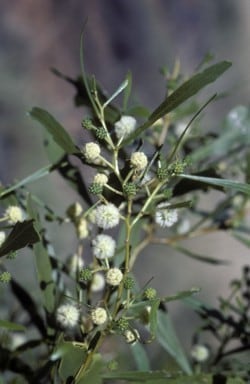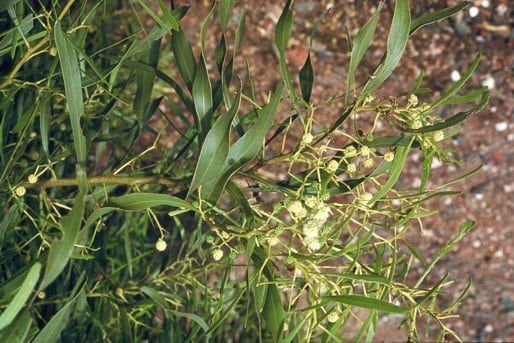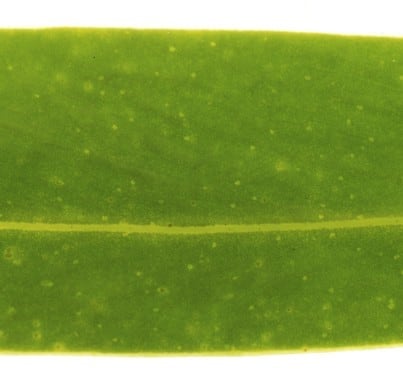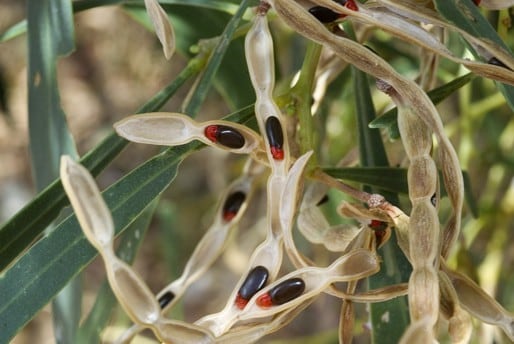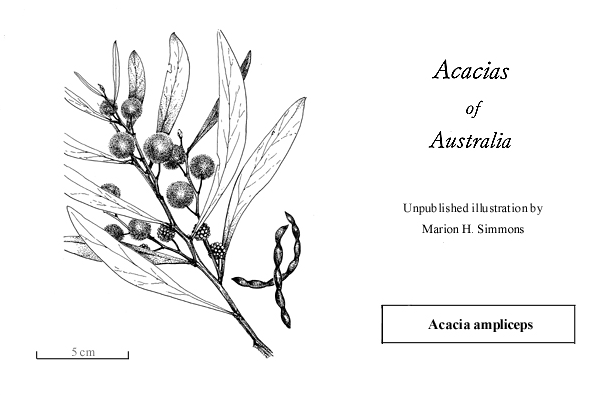Acacia ampliceps Maslin
WATTLE
Acacias of Australia
Common Name
Salt Wattle, Spring Wattle
Family
Fabaceae
Distribution
Widespread from Wooramel, through the Pilbara district, northern Great Sandy Desert and southern Kimberley region, W.A., E to Mataranka and Renner Springs, N.T.
Description
Bushy, rather untidy, large shrubs or small trees commonly 3–5 m tall, sometimes 6–7 (–9) m tall, occasionally prostrate. Branchlets often pendulous, yellowish, glabrous. Phyllodes commonly pendulous, variable, linear to lanceolate, sometimes narrowly obovate, 7–25 (–30) cm long, 7–30 (–40) mm wide, ±thin, light green, glabrous, prominently 1‑nerved, penninerved; glands 2, with lowermost prominent, 0–3 mm above pulvinus, and uppermost smaller and at base of mucro. Inflorescences terminal or axillary 2–11-headed racemes, with secondary phyllode sometimes developed at base of peduncles; raceme axes to 10 cm long, robust, glabrous, subtended when very young by bracts; peduncles 5–20 (–25) mm long, robust, glabrous; heads globular, large, subdense, 25-50-flowered, white to cream, not showy. Flowers 5-merous; calyx united, ±truncate or sinuate-toothed. Pods submoniliform, breaking readily at constrictions, to 11.5 cm long, 4–6 mm wide, ±woody, glabrous. Seeds longitudinal, oblong, 5–6.5 mm long, ±shiny, greyish brown to black; aril scarlet.
Phenology
Flowers May–Aug.
Habitat
Grows in sand or clay along watercourses, or in swales between coastal sandhills.
Specimens
W.A.: Millstream, M.I.H.Brooker 2059 (MEL, NSW, PERTH); upper Rudall R. area, B.R.Maslin 2296 (AD, CANB, K, MEL, NY, PERTH); 111 km E of Broome towards Derby, B.R.Maslin 2676 (AD, K, MEL, NY, PERTH); Wolf Creek Crater, 13 July 1974, J.H.Willis (PERTH). N.T.: Coomarie Springs, J.Maconochie 1733 (PERTH).
Notes
A member of the ‘A. bivenosa group’, distinguished most readily from A. ligulata and A. salicina by a combination of its thin, light green, commonly pendulous phyllodes, white, many-flowered heads and narrower pods. Past confusion of this species with A. salicina (syn. A. varians) is discussed by B.R.Maslin, Nuytsia 1: 316 (1974).
A moderately fast-growing but short-lived species which frequently spreads by root-suckering to form monospecific stands on moist sites. It has great potential for use in reclamation of salt-affected areas and as a low windbreak, fide J.W.Turnbull (ed.), Multi-purpose Austral. Trees & Shrubs 96–97 (1986). The foliage is very susceptible to insect attack.
Hybridises with A. bivenosa (see A. ampliceps × bivenosa) and probably also with A. sclerosperma subsp. sclerosperma (see A. ampliceps × sclerosperma subsp. sclerosperma) in the Pilbara region, W.A.
FOA Reference
Data derived from Flora of Australia Volumes 11A (2001), 11B (2001) and 12 (1998), products of ABRS, ©Commonwealth of Australia
Author
Edited by B.R.Maslin
A.R.Chapman, B.R.Maslin
This identification key and fact sheets are available as a mobile application:
URL: https://apps.lucidcentral.org/wattle/
© Copyright 2018. All rights reserved.


